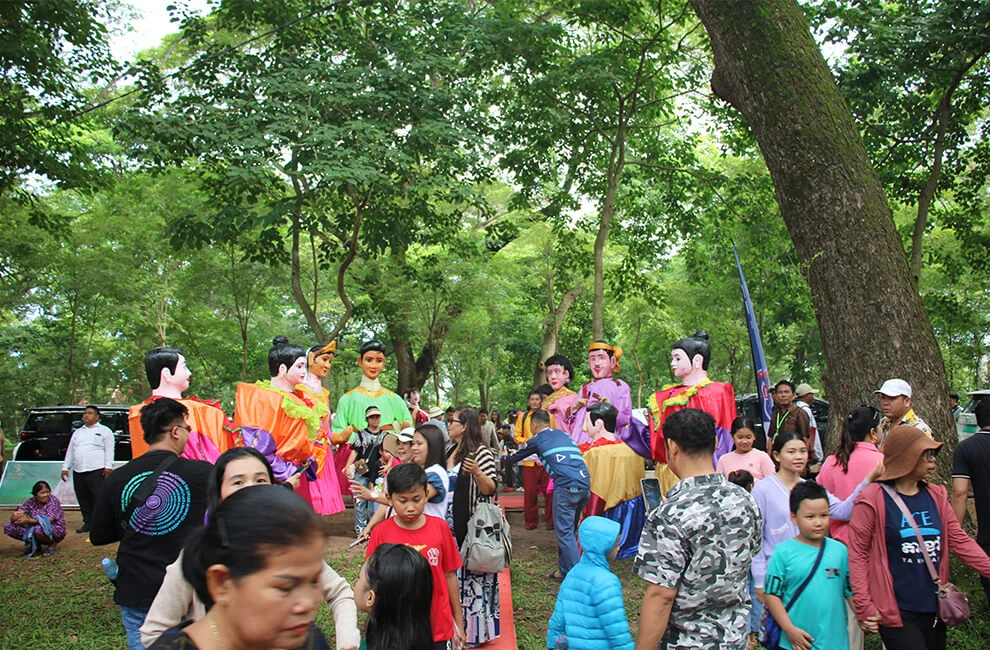Why Travel to Cambodia by Air from Thailand?
Cambodia and Thailand are two of the most popular tourist destinations in Southeast Asia, each offering unique experiences and attractions. Traveling by air between these two countries is not only time-efficient but also allows you to enjoy the comfort and convenience of modern aviation. With numerous flights operating daily, you can easily find a schedule that suits your travel plans.
Benefits of Flying from Thailand to Cambodia
- Time-Saving: Flights between Thailand and Cambodia are relatively short, with most journeys taking around 1 to 2 hours.
- Comfort: Air travel offers a comfortable and hassle-free experience, especially when compared to long overland journeys.
- Frequency: Multiple airlines operate daily flights between major cities in Thailand and Cambodia, providing flexibility in scheduling.
- Scenic Views: Flying offers breathtaking aerial views of the landscapes, including the Gulf of Thailand and the Mekong River.
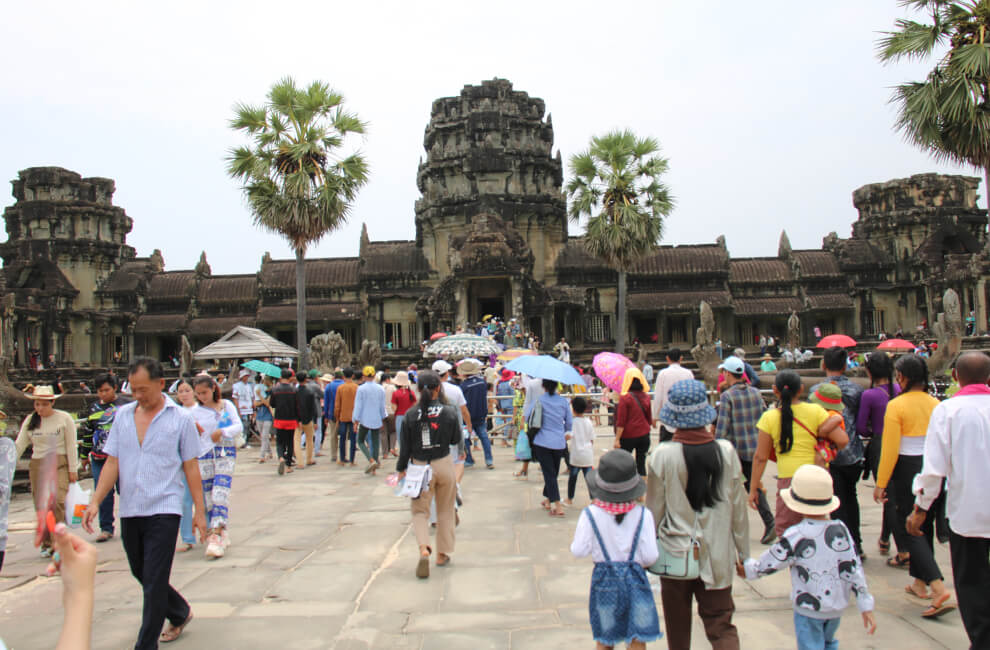
Preparing for Your Trip
Before embarking on your journey, it’s essential to make necessary preparations to ensure a smooth and enjoyable trip.
Visa Requirements
Most travelers visiting Cambodia will need a visa. Fortunately, obtaining a Cambodian visa is relatively straightforward.
- Visa on Arrival: Available at major airports in Cambodia, including Phnom Penh, Siem Reap, and Sihanoukville. You’ll need a passport valid for at least six months, a passport-sized photo, and the visa fee in USD.
- E-Visa: You can apply for an e-visa online before your trip. The e-visa is valid for 30 days and allows entry through designated airports and land borders.
- Visa Exemptions: Citizens of certain countries, such as ASEAN member states, may be exempt from visa requirements for short stays.
Best Time to Visit Cambodia
Cambodia has a tropical climate with two distinct seasons: the wet season (May to October) and the dry season (November to April).
- Dry Season (November to April): This is the most popular time to visit Cambodia, with pleasant temperatures and minimal rainfall. It’s ideal for exploring temples, beaches, and outdoor activities.
- Wet Season (May to October): While the wet season brings occasional heavy rains, it also offers lush landscapes and fewer tourists. Traveling during this time can be more affordable, and the rain usually doesn’t last all day.
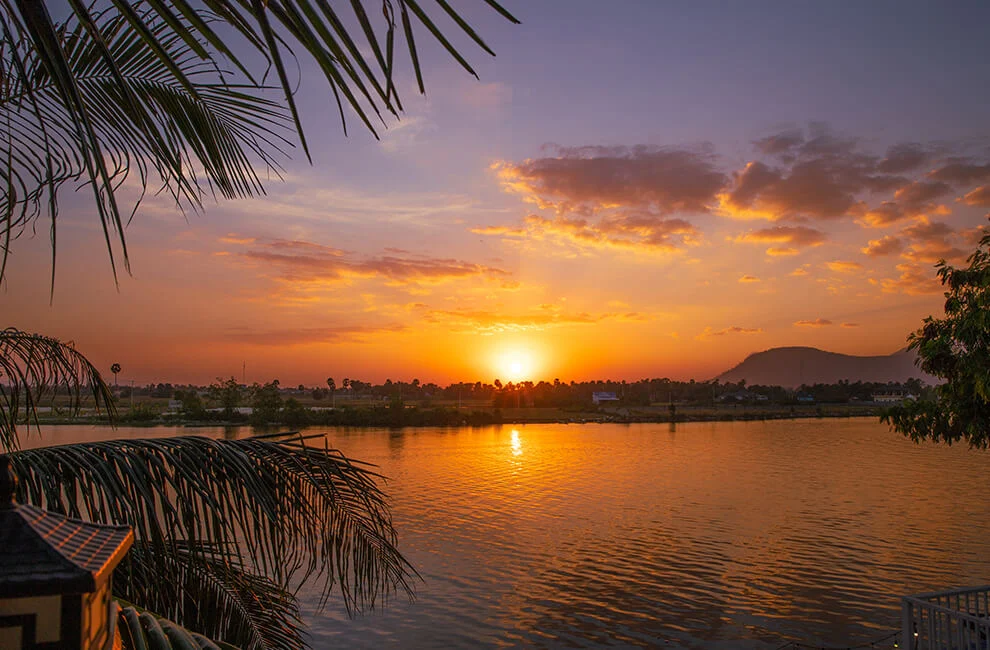
Health and Safety Tips
- Vaccinations: Ensure you’re up-to-date on routine vaccines. Consider vaccinations for Hepatitis A, Typhoid, and Tetanus. Malaria prophylaxis may be recommended if you’re visiting rural areas.
- Travel Insurance: It’s advisable to have travel insurance that covers medical expenses, trip cancellations, and emergencies.
- Stay Hydrated: Cambodia’s climate can be hot and humid, so drink plenty of water and stay hydrated.
- Food Safety: Stick to well-cooked meals and avoid street food that may not be prepared hygienically. Bottled water is recommended.
Booking Your Flight
Booking your flight is a crucial step in planning your trip. Here’s what you need to know to find the best options.
Airlines Operating Between Thailand and Cambodia
Several airlines operate flights between Thailand and Cambodia, offering a range of options to suit different budgets and preferences.
- Thai Airways: The national carrier of Thailand, offering direct flights from Bangkok to Phnom Penh and Siem Reap.
- Bangkok Airways: Known for its excellent service, Bangkok Airways operates flights from Bangkok to Siem Reap and Phnom Penh.
- AirAsia: A budget airline offering affordable flights from Bangkok and other Thai cities to Phnom Penh and Siem Reap.
- Cambodia Angkor Air: The national carrier of Cambodia, providing flights from Bangkok to Phnom Penh and Siem Reap.
- VietJet Air: A low-cost carrier offering flights from Bangkok to Phnom Penh and Siem Reap.
Finding the Best Deals
To get the best deals on flights, consider the following tips:
- Book in Advance: Flights tend to be cheaper when booked several months in advance.
- Flexible Dates: If your travel dates are flexible, use fare comparison websites to find the cheapest days to fly.
- Promotions and Discounts: Keep an eye out for airline promotions, discounts, and special offers.
- Loyalty Programs: If you frequently travel, consider joining airline loyalty programs to earn miles and enjoy perks.
Direct vs. Connecting Flights
- Direct Flights: Direct flights are the most convenient option, taking you from Thailand to Cambodia without any stops. They are ideal if you want to save time and avoid the hassle of layovers.
- Connecting Flights: Connecting flights may be cheaper but can involve longer travel times and layovers in other cities. If you choose a connecting flight, ensure you have enough time between flights to make your connection. From Thailand to Cambodia is no need connecting flights most are direct flight.
Airports in Thailand and Cambodia
Understanding the airports you’ll be using can help you navigate your journey more smoothly.
Major Airports in Thailand
- Suvarnabhumi Airport (BKK): Located in Bangkok, Suvarnabhumi is Thailand’s main international airport and a major hub for flights to Cambodia.
- Don Mueang International Airport (DMK): Also in Bangkok, Don Mueang primarily serves low-cost carriers and domestic flights.
- Chiang Mai International Airport (CNX): If you’re traveling from northern Thailand, Chiang Mai offers flights to Cambodia.
- Phuket International Airport (HKT): For those in southern Thailand, Phuket provides flights to Cambodia.
Major Airports in Cambodia
- Phnom Penh International Airport (PNH): The main gateway to Cambodia’s capital, Phnom Penh, offering flights from various Thai cities.
- Siem Reap International Airport (REP): Located near the famous Angkor Wat temple complex, Siem Reap Airport is a popular entry point for tourists.
- Sihanoukville International Airport (KOS): Serving the coastal city of Sihanoukville, this airport is ideal for travelers heading to Cambodia’s beaches and islands.
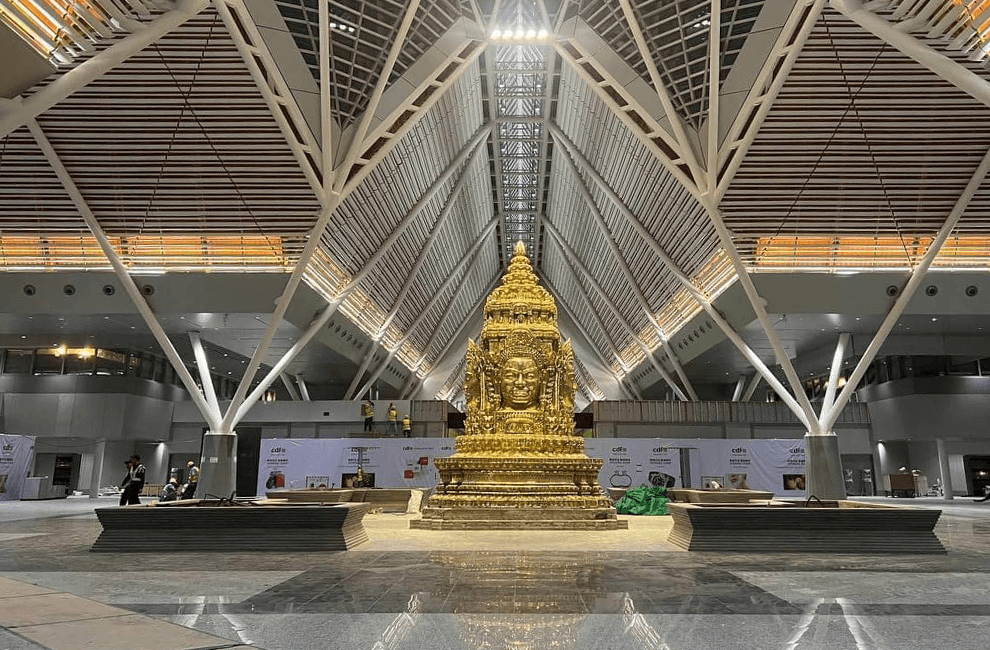
Navigating the airports in Thailand and Cambodia is generally straightforward, but it’s helpful to know what to expect.
Departure from Thailand
- Check-In: Arrive at the airport at least 2-3 hours before your flight to allow time for check-in, security, and immigration.
- Immigration: Have your passport, boarding pass, and any necessary visas ready for inspection.
- Security: Follow the airport’s security guidelines, including restrictions on liquids and prohibited items.
- Duty-Free Shopping: Take advantage of duty-free shopping at the airport for last-minute purchases.
Arrival in Cambodia
- Immigration: Present your passport, visa, and arrival card to the immigration officer. Ensure your visa is valid and correctly filled out.
- Baggage Claim: Proceed to the baggage claim area to collect your luggage. Check the baggage carousel number displayed on the screens.
- Customs: Declare any items that need to be declared and pass through customs. Be aware of Cambodia’s customs regulations to avoid any issues.
- Transportation: After exiting the airport, you’ll find various transportation options to take you to your destination.
Transportation from the Airport to Your Destination
Once you arrive in Cambodia, you’ll need to get from the airport to your accommodation or next destination. Here’s what you need to know.
Phnom Penh International Airport
- Taxis: Taxis are readily available at the airport. Ensure you agree on a fare before starting your journey or use a metered taxi.
- Tuk-Tuks: A popular and affordable option, tuk-tuks are a fun way to travel short distances.
- Ride-Hailing Apps: Apps like Grab are available in Phnom Penh and offer convenient and reliable transportation.
- Airport Shuttles: Some hotels offer airport shuttle services, so check with your accommodation in advance.
Siem Reap Angkor International Airport
- Taxis: Taxis are available at the airport, and fares are usually fixed. Confirm the price before getting in.
- Tuk-Tuks: Tuk-tuks are a common mode of transportation in Siem Reap and are ideal for short trips.
- Hotel Pickup: Many hotels in Siem Reap offer complimentary airport pickup, so arrange this in advance.
- Ride-Hailing Apps: Grab is also available in Siem Reap for convenient transportation.
Sihanoukville International Airport
- Taxis: Taxis are available at the airport, and fares are typically fixed. Confirm the price before starting your journey.
- Tuk-Tuks: Tuk-tuks are a popular and affordable option for short trips in Sihanoukville.
- Hotel Shuttles: Some hotels offer shuttle services, so check with your accommodation beforehand.
- Ride-Hailing Apps: Grab is available in Sihanoukville for convenient transportation.
Exploring Cambodia
Cambodia is a country rich in history, culture, and natural beauty. Here are some of the top attractions you won’t want to miss.
Top Attractions in Phnom Penh
- Royal Palace and Silver Pagoda: A stunning complex of buildings that serve as the residence of the King of Cambodia. The Silver Pagoda is known for its floor covered with over 5,000 silver tiles.
- National Museum of Cambodia: Home to the world’s finest collection of Khmer sculpture and artifacts, offering insights into Cambodia’s rich history.
- Tuol Sleng Genocide Museum (S-21): A sobering reminder of Cambodia’s tragic past under the Khmer Rouge regime.
- Choeung Ek Killing Fields: A memorial site dedicated to the victims of the Khmer Rouge, located just outside Phnom Penh.
- Wat Phnom: A historic temple located on a hill in the center of the city, offering panoramic views of Phnom Penh.
Must-See Sites in Siem Reap
- Angkor Wat: The largest religious monument in the world and a UNESCO World Heritage Site. Angkor Wat is a must-visit for its stunning architecture and historical significance.
- Angkor Thom: A fortified city that was the last capital of the Khmer Empire, featuring the iconic Bayon Temple with its massive stone faces.
- Ta Prohm: Known as the “Tomb Raider Temple,” Ta Prohm is famous for the giant trees that have grown over the ruins, creating a mystical atmosphere.
- Banteay Srei: A smaller temple known for its intricate carvings and pink sandstone construction.
- Tonle Sap Lake: The largest freshwater lake in Southeast Asia, offering floating villages and unique ecosystems.
Beaches and Islands in Sihanoukville
- Otres Beach: A quieter alternative to the main beaches in Sihanoukville, offering pristine sands and clear waters.
- Koh Rong: A tropical island known for its white sandy beaches, crystal-clear waters, and vibrant nightlife.
- Koh Rong Samloem: A more tranquil island compared to Koh Rong, ideal for relaxation and nature lovers.
- Ream National Park: A protected area offering hiking trails, mangrove forests, and diverse wildlife.
- Serendipity Beach: The most popular beach in Sihanoukville, known for its lively atmosphere and beachfront bars.
Cultural Etiquette and Tips
Understanding and respecting Cambodian culture will enhance your travel experience and help you connect with the locals.
Respecting Local Customs
- Dress Modestly: When visiting temples and religious sites, dress modestly by covering your shoulders and knees.
- Remove Shoes: It’s customary to remove your shoes before entering someone’s home or a temple.
- Respect Monks: Monks are highly respected in Cambodian culture. Avoid physical contact with monks, and women should not sit next to or touch a monk.
- Greetings: The traditional Cambodian greeting is the “sampeah,” where you place your palms together in a prayer-like gesture and bow slightly.
Language and Communication
- Khmer Language: The official language of Cambodia is Khmer. Learning a few basic phrases can go a long way in connecting with locals.
- Hello: Chum reap suor
- Thank you: Orkun
- Yes: Baht
- No: Ot te
- English: English is widely spoken in tourist areas, but learning some Khmer phrases can be appreciated by locals.
Currency and Tipping
- Currency: The official currency of Cambodia is the Cambodian Riel (KHR), but US dollars are widely accepted. It’s a good idea to carry small denominations of both currencies.
- Tipping: Tipping is not mandatory but is appreciated. In restaurants, a 10% tip is customary if a service charge is not included. For tuk-tuk drivers and tour guides, a small tip is a nice gesture.
Accommodation Options
Cambodia offers a wide range of accommodation options to suit every budget and preference.
Luxury Hotels
- Raffles Hotel Le Royal (Phnom Penh): A historic luxury hotel offering elegant rooms, a spa, and fine dining.
- Amansara (Siem Reap): A boutique hotel with a rich history, offering luxurious accommodations and personalized service.
- Song Saa Private Island (Koh Rong): A luxury resort on a private island, offering villas with private pools and stunning ocean views.
Budget-Friendly Stays
- The Pavilion (Phnom Penh): A charming boutique hotel with a pool, offering affordable rates in a central location.
- Onederz Hostel (Siem Reap): A popular hostel with clean and comfortable dormitories and private rooms.
- Happa (Sihanoukville): A budget-friendly hotel with modern amenities and a convenient location near the beach.
Unique Accommodations
- Shinta Mani Shack (Siem Reap): A socially responsible hotel offering luxurious tents and a focus on community development.
- 4 Rivers Floating Lodge (Koh Kong): A unique eco-lodge offering floating tents on the Tatai River, surrounded by nature.
- The Beige (Siem Reap): A luxury tented camp located near Angkor Wat, offering a blend of comfort and adventure.
Dining and Cuisine
Cambodian cuisine is a delightful blend of flavors, influenced by neighboring countries like Thailand and Vietnam.
Traditional Cambodian Dishes
- Amok: A traditional Cambodian curry made with fish, coconut milk, and spices, steamed in banana leaves.
- Bai Sach Chrouk: Grilled pork served with rice and pickled vegetables, a popular breakfast dish.
- Lok Lak: Stir-fried beef served with a tangy lime and black pepper sauce, often accompanied by rice and a fried egg.
- Nom Banh Chok: A traditional Khmer noodle dish made with rice noodles, fish-based green curry, and fresh vegetables.
- Kuy Teav: A flavorful noodle soup made with pork or beef broth, rice noodles, and various toppings.
Street Food Experiences
- Grilled Skewers: Various meats and vegetables grilled on skewers, often served with a dipping sauce.
- Fried Insects: A unique Cambodian street food experience, including fried crickets, tarantulas, and silk worms.
- Fresh Fruit: Cambodia offers a variety of fresh fruits, including mangoes, dragon fruit, and rambutan, often sold by street vendors.
- Khmer Pancakes: Crispy pancakes filled with beans, coconut, and other sweet or savory ingredients.
Fine Dining Options
- Malis (Phnom Penh): A fine dining restaurant offering a modern take on traditional Khmer cuisine.
- Cuisine Wat Damnak (Siem Reap): A highly acclaimed restaurant offering a tasting menu of Cambodian dishes made with local ingredients.
- The Sugar Palm (Siem Reap): A popular restaurant offering authentic Khmer cuisine in a traditional setting.
- Le Flore Angkor (Siem Reap): A modern Khmer style offering authentic Cambodian cuisine in a traditional mode.
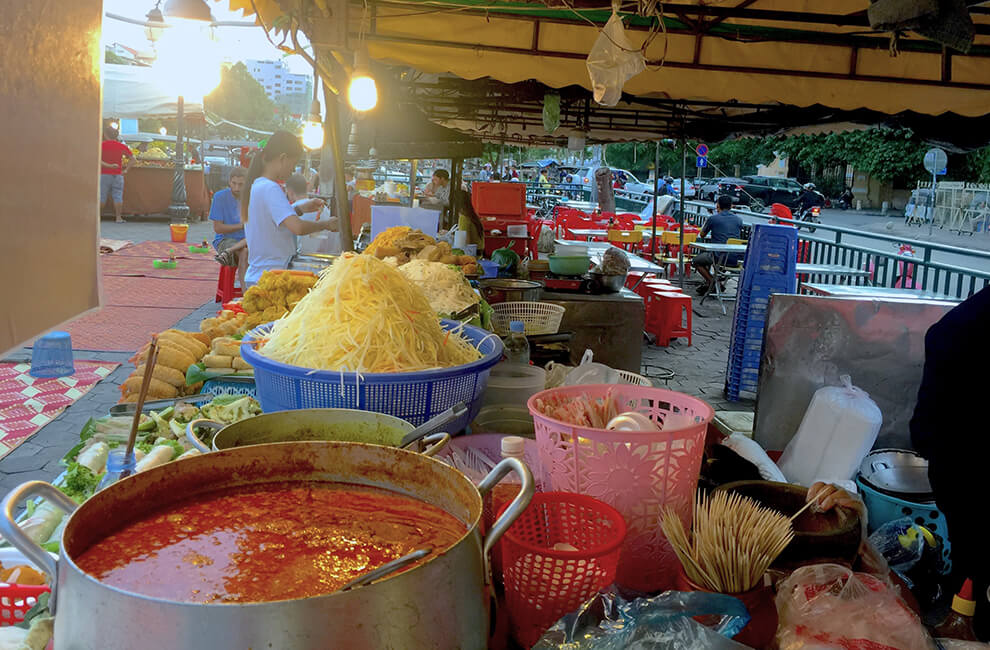
Shopping and Souvenirs
Cambodia offers a variety of shopping experiences, from bustling markets to upscale boutiques.
Local Markets
- Phsar Thmei (Central Market, Phnom Penh): A historic market offering a wide range of goods, including jewelry, clothing, and souvenirs.
- Phsar Chas (Old Market, Siem Reap): A bustling market offering everything from fresh produce to handicrafts and souvenirs.
- Phsar Leu (Sihanoukville): A large market offering a variety of goods, including clothing, electronics, and local products.
Handicrafts and Art
- Artisans Angkor (Siem Reap): A social enterprise offering high-quality handicrafts, including silk products, carvings, and paintings.
- Rajana (Siem Reap): A fair-trade shop offering handmade jewelry, accessories, and home decor items.
- Smateria (Phnom Penh): A boutique offering eco-friendly bags and accessories made from recycled materials.
Duty-Free Shopping
- Phnom Penh International Airport: Offers a range of duty-free shops selling alcohol, tobacco, perfumes, and cosmetics.
- Siem Reap International Airport: Features duty-free shops with a selection of luxury goods, including jewelry, watches, and electronics.
- Sihanoukville International Airport: Offers duty-free shopping with a focus on local products and souvenirs.
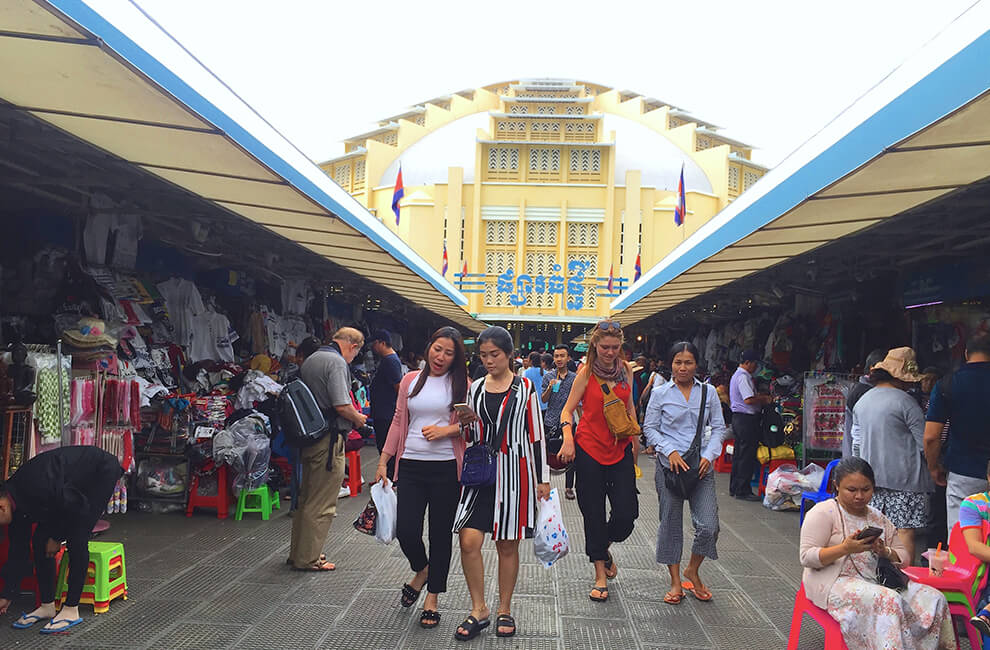
Traveling Within Cambodia
Getting around Cambodia is relatively easy, with various transportation options available.
Domestic Flights
- Cambodia Angkor Air: Offers domestic flights between Phnom Penh, Siem Reap, and Sihanoukville.
- Bassaka Air: Operates domestic flights between Phnom Penh and Siem Reap.
Buses and Trains
- Buses: Buses are a popular and affordable way to travel between cities in Cambodia. Companies like Giant Ibis and Mekong Express offer comfortable and reliable services.
- Trains: The Royal Railway operates train services between Phnom Penh and Sihanoukville, offering a scenic journey through the countryside.
Tuk-Tuks and Taxis
- Tuk-Tuks: Tuk-tuks are a common and affordable mode of transportation for short distances within cities.
- Taxis: Metered taxis are available in major cities like Phnom Penh and Siem Reap. Ride-hailing apps like Grab are also widely used.
Day Trips and Excursions
Cambodia offers a variety of day trips and excursions that allow you to explore the country’s natural beauty and cultural heritage.
Angkor Wat and Surrounding Temples
- Angkor Wat: Spend a full day exploring the iconic Angkor Wat temple complex, including the main temple, the surrounding moat, and the intricate bas-reliefs.
- Angkor Thom: Visit the ancient city of Angkor Thom, including the Bayon Temple, the Terrace of the Elephants, and the Terrace of the Leper King.
- Ta Prohm: Explore the jungle-covered ruins of Ta Prohm, famous for the giant trees growing over the temple structures.
Tonle Sap Lake
- Floating Villages: Take a boat tour of the floating villages on Tonle Sap Lake, including Chong Kneas and Kampong Phluk, to experience the unique way of life on the water.
- Bird Sanctuary: Visit the Prek Toal Bird Sanctuary, home to a variety of bird species, including storks, pelicans, and ibises.
Bokor National Park
- Bokor Hill Station: Explore the abandoned French colonial buildings and enjoy panoramic views from the Bokor Hill Station.
- Popokvil Waterfall: Visit the picturesque Popokvil Waterfall, located within Bokor National Park.
Sustainable Travel Practices
As a responsible traveler, it’s important to minimize your impact on the environment and support local communities.
Eco-Friendly Tours
- Community-Based Tourism: Participate in community-based tourism initiatives that support local communities and promote sustainable practices.
- Eco-Tours: Choose eco-tours that focus on conservation and environmental education, such as wildlife watching and nature hikes.
Supporting Local Communities
- Buy Local: Purchase souvenirs and products from local artisans and markets to support the local economy.
- Stay Local: Choose locally-owned accommodations and restaurants to contribute to the local community.
- Volunteer: Consider volunteering with local organizations that focus on education, conservation, or community development.
Reducing Your Carbon Footprint
- Use Public Transportation: Opt for public transportation, cycling, or walking to reduce your carbon footprint.
- Reduce Plastic Use: Bring a reusable water bottle and avoid single-use plastics to minimize waste.
- Conserve Energy: Turn off lights, air conditioning, and electronics when not in use to conserve energy.
Conclusion
Traveling to Cambodia by air from Thailand is a convenient and enjoyable way to explore the rich cultural heritage, stunning landscapes, and vibrant cities of these two Southeast Asian nations. By following this comprehensive guide, you’ll be well-prepared to plan your journey, navigate the airports, and make the most of your time in Cambodia. Whether you’re visiting the iconic Angkor Wat, relaxing on the beaches of Sihanoukville, or exploring the bustling streets of Phnom Penh, Cambodia offers a wealth of experiences that will leave you with lasting memories. Safe travels!


